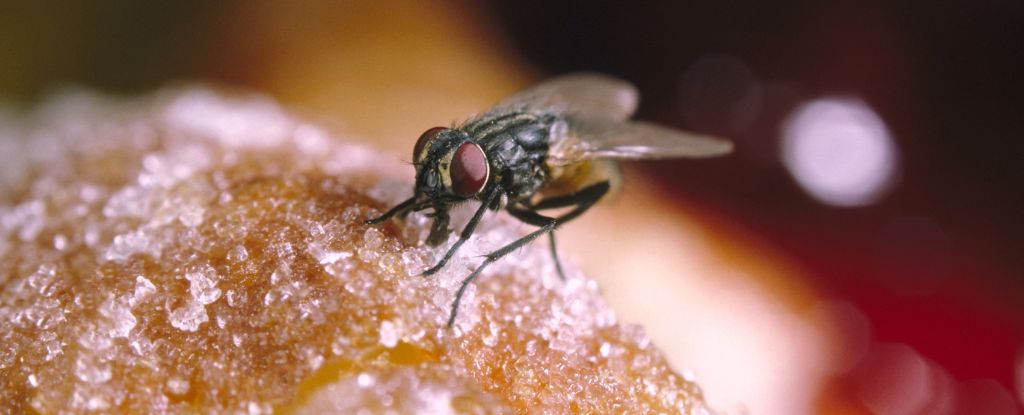Why House Fly Barf Is an Overlooked Potential Vector of Disease

The next time a fly lands on your food, you might want to consider throwing that bite away. A new review suggests the muck that flies regurgitate could very well be infected with a pathogen.
When you think of a disease-carrying insect, chances are you imagine a blood-sucking mosquito or tick. But recent findings suggest your average non-biting house fly (Musca domestica) may pose a bigger threat to human health than is often considered.
House flies contain an organ at the start of their gut known as a crop, which stores food before digestion. This organ also makes a great place for microbes and parasites to hide.
When a fly lands on your food, there’s a good chance the insect will vomit up some of the contents of their crop and some digestive enzymes. Without teeth, this is how the fly breaks down its meal so it can be sucked up via its straw-like mouth.
As well as spewing enzymes, it’s possible the fly can also retch viruses and bacteria from its crop, which were previously picked up from other food sources, like wounds, saliva, mucus, or poop.
A recent review on this overlooked route of transmission was initially prompted by the outbreak of the COVID-19 pandemic, when the author, entomologist John Stoffolano, read a book called Spillover: Animal Infections and the Next Human Pandemic.
As Stoffolano flipped through the pages, he realized that the house flies he’d been working on for over half a century had been largely ignored as disease transmitters.
“I’ve been working on [non-biting] flies since I was a graduate student in the 1960s. And [non-biting] flies have largely been ignored,” says Stoffolano from the University of Massachusetts Amherst.
“Blood-feeding flies have taken the limelight, but we should pay attention to the ones that live among us because they get their nutrients from people and animals that shed pathogens in their tears, feces, and wounds.”
Because flies are attracted to filth, like dead animals and their feces, non-biting insects are likely to spread pathogens from one animal to another as they buzz around.
According to one recent study, more than 200 different pathogens have been found in adult house flies, including some bacteria, viruses, worms, and fungi.
In 2020, researchers showed in lab experiments that house flies could even carry SARS-CoV-2, mechanically transporting the live virus to new hosts on their legs, wings, or mouthparts.
But it’s not just mechanical transmission we need to worry about. In the 1990s, a study found that Escherichia coli bacteria can proliferate in and on the mouthparts of house flies.
In hindsight, Stoffolano now thinks this happens because flies are constantly spewing up the contents of their crop during feeding and grooming (where insects smear vomit all over themselves).
In 2021, for instance, a study found that house flies infected with Chlamydia tachomatis could keep this pathogen alive in their crop for 24 hours – plenty of time to fly off and regurgitate on a new host.
Another study found pathogens can remain in the crop for at least 4 days.
While scientists continue their work to understand these filthy creatures, keep in mind, though, that the risks are low if food isn’t left outside too long.
“While there is little doubt that flies can carry bacteria, viruses, and parasites from waste to our food, a single touchdown is unlikely to trigger a chain reaction leading to illness for the average healthy person,” University of Sydney entomologist Cameron Webb wrote in 2015.
Nevertheless, many studies to date that have examined the insides of flies for pathogens have not specified what part of the fly they dissected. Steffano says that researchers should examine the crop as it contains more fluid for microbes and possibly parasites to bathe in.
Researchers should also take note that some fly species have larger crops and, therefore, may be able to transport more pathogens, posing a greater risk when those insects roam.
“It’s the little things that cause the problems,” Stoffolano says. “Our health depends on paying closer attention to these flies that live with us.”
The study was published in Insect.
